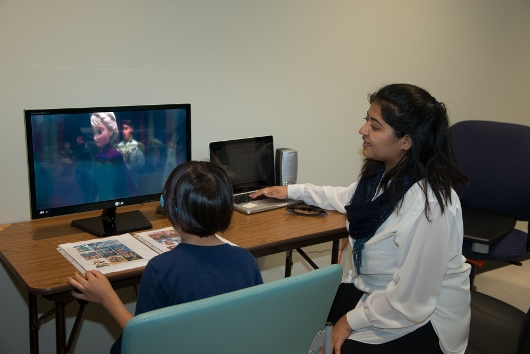Watching Movies Could Help Treat Children with Lazy Eye
Researchers at the Retina Foundation of the Southwest are developing a new and unique approach to treating amblyopia, “lazy eye,” that may likely be one of the most innovative approaches of our time. They are conducting a new study to determine whether dichoptic movie viewing helps to improve vision for children with lazy eye.
Dichoptic is having a separate and different field of view from each eye. In the study, children with lazy eye view their favorite animated feature films on a passive 3D display. The custom software that has been developed for this treatment method presents parts of the image with low contrast to the fellow eye and parts of the image with high contrast to the lazy eye. The child has to combine the information from both eyes to piece together the whole movie.
“Amblyopia (lazy eye) develops when binocular vision is disrupted by crossed-eyes or blurry vision in one eye. Trying to implement a recovery by patching one eye, hoping it will help binocular vision, isn’t logical,” said Dr. Eileen Birch, Director, Crystal Charity Ball Pediatric Vision Evaluation Center at the Retina Foundation. “The new movie treatment ensures that the lazy eye gets the visual stimulation it needs to improve vision and ensures that the two eyes cooperate to work together.”
Our researchers recently led the development of specially designed iPad games as an alternative to patching treatment. They used the same contrast-balancing approach as the movies, with low contrast areas of the game screen presented to the fellow eye and high contrast areas to the amblyopic eye. There has been great interest in adopting the new iPad game approach because it treats the underlying binocular problem as well as strengthening the vision of the amblyopic eye.
Based on our initial studies, the National Eye Institute is funding the Pediatric Eye Disease Investigator Group to conduct a randomized clinical trial to compare the iPad game treatment to patching therapy for amblyopia at sites across North America.
While the iPad games are effective, they also are repetitive and boredom results in up to 40% of children becoming noncompliant. Therefore, our researchers at the Retina Foundation of the Southwest began investigating the efficacy of a potentially more engaging movie method that could also provide contrast-balanced binocular experience along with complementary dichoptic stimulation. This approach would also allow even younger patients the ability to receive this new treatment for amblyopia.
“Amblyopia is the most common form of monocular visual impairment affecting children. One or two children in every classroom in the U.S. have amblyopia. We need to find better ways to detect it earlier and treat it more effectively for a lifetime of better vision,” said Dr. Birch.
To stay informed about news and events within the Retina Foundation of the Southwest, sign up for our monthly e-newsletter, Recently@Retina.

Related Articles
Recently@Retina Newsletter August 2024 Investigating the Impact of Lazy Eye on Reading Speed and Motor Skills in Children – Video Update Retina Foundation Helps Avery COVID-19 Guidelines For Retina Foundation Staff and Visitors Retina Foundation Has Eye on $1 Million Goal for Annual Visionary Luncheon